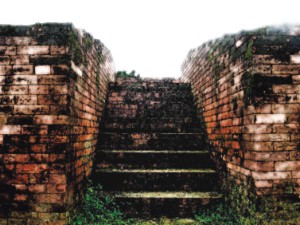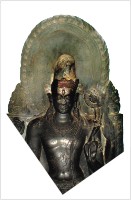Celebrating Bangladesh Series

By Adnan M. S. Fakir
 Mahasthangarh, about 13 km from Bogra, is probably the largest of all our relics in Bangladesh and the oldest. From what I know of, several universities have had trips to this ancient city, so it is not as unheard of as many other sites. The city, now entirely in ruins, dates back to 700 BC and currently has 8 excavated sites, with 31 others left to be excavated. Of course with the rate our government is advancing, we probably won't be able to see any of those un-excavated parts in our lifetime. Anyways, with civilizations repeatedly inhabiting this city, this place is literally a timeline of our history.
Mahasthangarh, about 13 km from Bogra, is probably the largest of all our relics in Bangladesh and the oldest. From what I know of, several universities have had trips to this ancient city, so it is not as unheard of as many other sites. The city, now entirely in ruins, dates back to 700 BC and currently has 8 excavated sites, with 31 others left to be excavated. Of course with the rate our government is advancing, we probably won't be able to see any of those un-excavated parts in our lifetime. Anyways, with civilizations repeatedly inhabiting this city, this place is literally a timeline of our history.
Mohasthangarh used to be the capital of the Pundra Kingdom and was known as Pundranagara in 700 BC. Indicative by several brahmi inscriptions, Mohasthangarh is known to have been consequently inhabited by several, including the Maurya, Gupta and Pal dynasties. There are also marks of Afghan settlements within Mahasthan from during the beginning of Muslim rule in Bangladesh, in the 12th Century. The museum there wonderfully traces the different settlements of Mohasthan, along with the artifacts found in order to substantiate their existence.
Since most of the ruins of Mohasthan pretty much look the same, we will be specifically talking about the tomb of Shah Sultan Mahisawar, Jiyat Kundu also called the Well of Life, the Govindo Bhita, Narapatir Dhap or Vasu Vihar and the famous Gokul Medh, more commonly known as Behula's Nuptial House. These places themselves are pretty interesting as two very separate stories encompass them: one involving revenge, anger & religious warfare while the other of pride, ego and love.
Shah Sultan and the Well of Life: the story of Revenge, Anger & Religious Warfare!
 After the Pal dynasty, during the reign of Pashuram in the 12th century, Hindu was the widespread religion of Mahasthan and the killing of cows was banned. Evidently, as the story goes, there used to be a Muslim man named Borhanuddin. He did not have any children and he prayed to God that if he ever has any child, he will sacrifice a cow. Months later, he had a son, and keeping his word, he secretly sacrificed a cow and buried its remains. However, the locals saw the incident and reported so to the king, Pashuram. Pashuram called upon Borhanuddin who, on inquiry, told the truth to the king. Pashuram furious, took away Borhanuddin's son and sacrificed him to the Hindu God, Kali.
After the Pal dynasty, during the reign of Pashuram in the 12th century, Hindu was the widespread religion of Mahasthan and the killing of cows was banned. Evidently, as the story goes, there used to be a Muslim man named Borhanuddin. He did not have any children and he prayed to God that if he ever has any child, he will sacrifice a cow. Months later, he had a son, and keeping his word, he secretly sacrificed a cow and buried its remains. However, the locals saw the incident and reported so to the king, Pashuram. Pashuram called upon Borhanuddin who, on inquiry, told the truth to the king. Pashuram furious, took away Borhanuddin's son and sacrificed him to the Hindu God, Kali.
During that time period, Islam was being preached in parts of Bengal and Muslim rule was gradually taking over. Borhanuddin, reclaimed his son's dead body and went to a Muslim council in Chittagong, and pleaded for justice. Consequently, Shah Sultan was sent to Mahasthan to preach Islam and lore has it that Shah Sultan arrived via the river, riding a great fish, giving him the Mahisawar title which is a Sanskrit word meaning “man who rides a fish”. As Sultan laid down his prayer mat on a hillock, Pashuram, furious that anyone would dare openly practice Islam on his land, declared war.
 The battle began and it is at this point that the lore of Jiyat Kundu, also called the Well of Life is first mentioned. Tradition ascribes that King Pashuram resurrected his dead soldiers with the water from this well during the war with Shah Sultan and his followers, which is definitely a handy thing to have at time of war. Sultan soon learned about this well and polluted it by dropping a piece of beef inside the well with the aid of a kite. Supposedly, the well's water then lost its power and slowly the armies of Pashuram diminished till Shah Sultan defeated the king using his staff. Pashuram was not killed but he fled and Sultan preached Islam in Mohasthan till his death. His tomb remains here and has been greatly renovated, and a mosque has been built where Shah Sultan had first laid his prayer mat.
The battle began and it is at this point that the lore of Jiyat Kundu, also called the Well of Life is first mentioned. Tradition ascribes that King Pashuram resurrected his dead soldiers with the water from this well during the war with Shah Sultan and his followers, which is definitely a handy thing to have at time of war. Sultan soon learned about this well and polluted it by dropping a piece of beef inside the well with the aid of a kite. Supposedly, the well's water then lost its power and slowly the armies of Pashuram diminished till Shah Sultan defeated the king using his staff. Pashuram was not killed but he fled and Sultan preached Islam in Mohasthan till his death. His tomb remains here and has been greatly renovated, and a mosque has been built where Shah Sultan had first laid his prayer mat.
The only problem with this story is that we don't know how much of the Jiyat Kundu, the Well of Life, is actually true... we will leave that for you to decide.
Govindo Bhita & Vashu Bihar
Moving deeper into the ancient city, from right across the Museum, lies the Govindo Bhita. This supposedly housed a temple in tribute to Vishnu around the 3rd century BC. Situated right beside the Karatoya River, now however, there really is not much left of it.
Vashu Bihar or the Narapatir Dhap also pretty much looks like an excavated site of moulds, however there is more to this place than the Govindo Bhita. Over 800 cultural objects including bronze and stone statues, terracotta plaques, oil lamp, Brahmi inscriptions, and others were found here dating back to the 10th Century. More importantly, this was also one of the oldest universities of Bengal and contained over 24 rooms to house the scholars!
Behula's Nuptial House: the story of Pride, Ego and Love!
 In case you are wondering, yes, this huge excavated mound IS the nuptial house (hopefully, the picture of the nuptial house got printed along the article). If you are also wondering why anyone would want to spend their wedding night in a house like this? Well, tradition and folk lore does answer that question.
In case you are wondering, yes, this huge excavated mound IS the nuptial house (hopefully, the picture of the nuptial house got printed along the article). If you are also wondering why anyone would want to spend their wedding night in a house like this? Well, tradition and folk lore does answer that question.
According to the story, Behula was a beautiful and intelligent woman, married to Lakhindar, the youngest son of Chand Saodagar, who was a devotee of the Hindu Goddess, Shiva. Chand Saodagar boasted that he was cleverer and stronger than Manasa, the snake goddess. Manasa was much offended by this and slowly killed Saodagar's sons one after another. In order to protect Lakhindar and Behula on their wedding, he built an iron house, believing it to be impregnable. This iron house is the presently excavated seemingly large mould and has been named “Behula's Nuptial House.”
As the story continues, on the wedding night of Behula and Lakhindar, Manasa sent a snake as fine as a strand of hair which entered the chamber through a minute hole, and bit Lakhindar. Ultimately Behula was the one who went to Manasa and managed to save Lakhindar, by convincing Manasa with her sweet voice beautiful dancing skills, however, Saodagar had to bow down to the snake Goddess.
In the story, Behula not only personifies the typical Bengali woman's traditional love for her husband, but also her strength and courage, which is why the nuptial house has been named after her.
In Conclusion
Mohasthangarh also used to be surrounded by a wall all around the city for protection, similar to but a (much) smaller size of the Great Wall of China you may say; this also has a story revolving around it, although right now the extending wall is only a few feet high. This ancient city is manifested with fascinating stories that go with several of its other excavated sites. While the relics appear simply to be excavated moulds, when the story behind them is uncovered and known, the place becomes a lot more interesting and almost alive. With a proper guide, this certainly is an incredible historical site to visit.


Universe at War
Earth Assault is an attempt to deliver an old-school real-time strategy game that features three incredibly unique and distinct factions. And that too by introducing three alien races
The story
When a malevolent alien race known as the Hierarchy invades Earth to turn its inhabitants and belongings into raw material, all hope seems lost. Then, a crusading army of sentient machines called Novus arrives to battle the Hierarchy. Their fighting awakens a long-lost race that was hiding on Earth, the Masari. And, thus, the stage is set for an intergalactic war on Earth's surface.
The differences among the three factions are deep. The Novus build a network node that can encompass the map, which allows them to quickly shift forces around in the blink of an eye. The Hierarchy is like a destructive force of nature because their harvesters scour the map for raw materials while their lumbering walker war machines are like land battleships. Then there's the Masari, which might be the most conventional of the three because they center on the construction of a powerful base and defenses. However, the Masari have the most powerful and expensive units in the game.
The game
Universe at War's single-player campaign at first follows the traditional scripted campaigns of most RTS games. You begin as the Novus then move onto the Hierarchy as the game's tale of war and betrayal unfolds. When you pick up as the Masari in the third act, things change. Out goes the scripted storyline and in comes the global strategic metagame, which is like a big game of Risk. You decide which territory to invade next and then resolve the battles in real time. It's not a particularly deep strategic layer, but it does help shake up the formula a bit.
The problems
Universe at War suffers from some key issues. The most noticeable is the zoom level, which is almost nonexistent. If you can imagine playing a game with your face just inches from the screen, that's what Universe at War feels like at times. It's annoying to see a single Hierarchy walker fill up more than half the screen and realize that you can't pull the camera back any farther. It's such an artificial and painful limitation not being able to actually see the battlefield. The controls are also clumsy. If you try to click on a unit, at times, it won't register. Or if you try to double-click on a unit to select all of its type on the screen, it won't register at times.
The looks
Graphically, Universe at War has some pretty units, like the aforementioned walkers. They look almost organic in nature, with their glistening skin and bulbous curves. However, the rest of the game's visuals are a bit dated, from the blocky, polygonal look of many of the characters to the generally bland textures. The game does feature support for DirectX 10, but DX10 performance comes to an absolute crawl, even on a high-end PC that can run Crysis at maximum detail.
The audio
Upon load, the game starts with a chilling and brutal cinematic scene that wouldn't be out of place in Spielberg's War of the Worlds movie. The scene shows human infantry brutally and mercilessly cut down by relentless, unstoppable alien war machines. Unfortunately, the tone of that scene is quickly lost because the game features corny dialogue that seems taken from a cartoon.
Aside from the unique races, Universe at War doesn't really introduce anything new to the genre. If anything, this is a very traditional real-time strategy game in the vein of Command & Conquer.

Cast & Credits
Sweeney Todd: Johnny Depp
Mrs. Lovett: Helena Bonham Carter
Judge Turpin: Alan Rickman
Beadle Bamford: Timothy Spall
Pirelli: Sacha Baron Cohen
Johanna: Jayne Wisener
Anthony Hope: Jamie Campbell Bower
Tim Burton's film adaptation of "Sweeney Todd: The Demon Barber of Fleet Street" smacks its lips at the prospect of such a meal, and so it should. In telling this story, half-measures will avail him nothing. The bloodiest musical in stage history, it now becomes the bloodiest in film history, and it isn't a jolly romp, either, but a dark revenge tragedy with heartbreak, mayhem and bloody good meat pies.
But we know that going in and are relieved that Burton has played true to the material.
It has what is much better, a satisfactory mixed ending, in which what must happen, does. Along the way, with merciless performances by Johnny Depp, Helena Bonham Carter and Alan Rickman, with a brooding production design by Dante Ferretti, with the dark shadows of Dariusz Wolski's cinematography, it allows Burton to evoke the 19th century London of Henry Mayhew's Labour and the London Poor, which reported on the dregs of London and greatly influenced Charles Dickens. The worst you've heard about Calcutta would have been an improvement on London poverty in those days.
The acting is so good that it enlists us in the sordid story, which even contains a great deal of humor -- macabre, to be sure.

The plot: In London years earlier lived a barber named Benjamin Barker (Johnny Depp) and his sweet young wife and child, and he loved them. But the vile Judge Turpin (Alan Rickman) sentenced Barker on trumped-up charges and had him transported to Australia, meanwhile capturing his wife and child. After Turpin ravishes the wife, destroying her life, the girl Johanna (Jayne Wisner) grows up to become the judge's ward and prisoner.
As the film proper opens, Benjamin has escaped from prison Down Under and sails into London with young Anthony Hope (Jamie Campbell Bower). He races through the streets to his former barbershop, where the landlady is still the dark-eyed beauty Mrs. Lovett (Helena Bonham Carter), who sells the worst meat pies in London. She tells him about the fate of his family. He moves upstairs to his former shop, now a ruin, changes his name to Sweeney Todd and sets up in business again.
But so deep is his rage that he makes an architectural improvement: a sliding chute that will drop his customers straight into the basement after he slits their throats, so Mrs. Lovett can cut them up and bake them into her pies. Now she offers the meatiest and most succulent meat pies in London; business booms, and sometimes satisfied customers go upstairs for a haircut and a quick recycling.
Depp and Bonham Carter do their own singing, and very well, too, and as actors, they use the words to convey meaning as well as melody.
There are also star turns by Sacha Baron Cohen, as the rival Italian barber Pirelli, whose singing career ends dramatically rather early in the film. And by Rickman as the judge and the invaluable Timothy Spall as Beadle Bamford, his flunky.
"Sweeney Todd" combines some of Tim Burton's favorite elements: The fantastic, the ghoulish, the bizarre, the unspeakable, the romantic and in Johnny Depp, he has an actor he has worked with since "Edward Scissorhands" and finds a perfect instrument.
